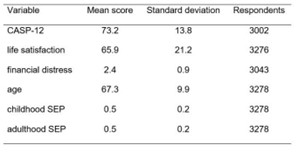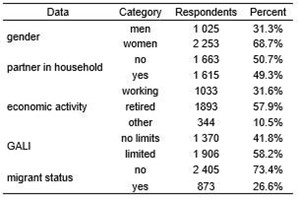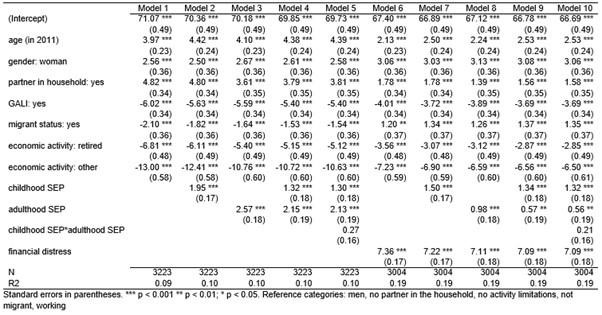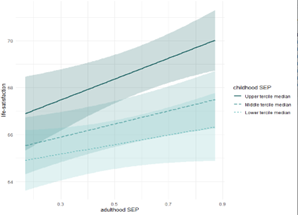Introduction
Several research studies have revealed that there is increasing diversity among older populations (Blane et al., 2007; Calvo et al., 2018; Elder, 1998; Ferraro & Shippee, 2009; Moen, 2016; Moen et al., 2022; Pinquart & Sörensen, 2000). Conditions and events over each individual's life course are part of the increasing differentiation, with one major difference being their material resources (Crystal & Waehrer, 1996; Dannefer, 1987; Deindl, 2013; Neugarten, 1985; Niedzwiedz et al., 2012; Niedzwiedz et al., 2015; Wahrendorf & Blane, 2015; Wildman et al., 2018). The type of welfare regime that individuals are exposed to throughout their life course could be a key modifier of their life-course socio-economic position and perhaps also their well-being at later ages (Niedzwiedz et al., 2015).
It is our goal to investigate to what extent accumulated socio-economic position (SEP) across the entire life course affects the current quality of life (QoL). In our study, we focus on the accumulation model. Current financial distress helps to shed light on how subjective feelings regarding well-being and life satisfaction are affected by the amount of objective resources that have been accumulated.
Our study has three research questions: 1) how childhood and adulthood SEP affect two measures of QoL; 2) how current financial distress affects the impact of life-course SEP on current QoL; and 3) whether interactions of childhood and adulthood SEP on current QoL of older people are of cumulative or compensatory nature (Erola & Kilpi-Jakonen, 2017).
There are several reasons why the Estonian population is used for this study. Our interest lies in understanding the cumulative effects of socioeconomic (dis)advantages over the life course, and Estonia's older population has gone through multiple, societal transformations over their life course concerning policies regulating material resources.
Firstly, their youth took place in a planned economy and totalitarian regime. Socio-political transformations after WWII in Central and Eastern Europe (CEE) legally restricted both the accumulation and heritability of wealth, rendering irrelevant these most long-lasting factors of the family impact (Saar & Helemäe, 2021). Intergenerational continuity between the pre-war generation and their children was brutally targeted by Sovietisation policies, which increased the perishability of family, and cultural resources (Helemäe & Saar, 2022; Sakkeus et al., 2016).
Secondly, their adult years fell in the first stages of capital accumulation during the transition to a democratic society in the 1990s (Sakkeus et al., 2016). After the collapse of the socialist state regimes, the CEE countries opted for their own, distinct paths towards a market-based economy (Bohle & Greskovits, 2007), and Estonia represents a case of early and radical liberalisation (Lugus & Hatchey, 1995).
Thirdly, Estonia has a rather meagre and basic social security provision for their older population, thus leading to particularly high poverty rates: nearly 30% of older people in the mid-2000s were at risk of poverty (Ebbinghaus, 2019), and Estonia still has one of the largest proportions of people over the age of 65 at risk of poverty in the EU.
Theoretical framework and previous empirical results
This study is guided by theories regarding life course and cumulative (dis)advantages. Life course theory's core principle is that adaptations in later years are linked to earlier experiences in life (Crosnoe & Elder, 2002; Elder & Johnson, 2003). Cumulative (dis)advantage and inequality theories (Dannefer, 2003; Ferraro & Shippee, 2009) suggest that inequalities arise from birth or even before, persist, and increase throughout the life course.
Elder (1998) and Elder, Johnson and Crosnoe (2003) expand on life course theory with the following principles: 1) the principle of agency, where people make decisions that determine their life course within a framework of predetermined limitations and opportunities; 2) the principle of lifespan development, where human development and ageing are processes that last throughout the life cycle; 3) the principle of time and place, where a life course is shaped by location and socio-historical context; 4) the principle of timing, where historical events, together with individual experiences, shape the life course depending on when they have occurred; and 5) the principle of linked lives, where life courses are interrelated with those of other people, and are therefore interdependent.
Patterns of inequality appear as a combination of institutional and individual influences (O'Rand, 1996) through between-group inequalities and path-dependent cumulative (dis)advantages, with our study focusing on the latter (DiPrete & Eirich, 2006).
From the moment people are born, they follow paths regarding roles, settings, and relationships that could influence later stages of life, described by either supplemental or mediational approaches. In the supplemental approach, previously acquired experiences add to how smooth or rough later life circumstances will be (Shanahan et al., 2003), and in the mediational approach, experiences accumulate over time, thus predicting the necessary adjustments later in life (Clausen, 1991; Kiernan & Cherlin, 1999; Vaillant, 1983). Crosnoe and Elder's (2004) findings suggest that early experiences may have long-term consequences, but may not necessarily be cumulative due to the formed patterns of adjustment.
As both theories relate to the passage of time, they have clear theoretical and empirical connections, especially regarding heterogeneity and inequality. This perspective has been developed and implemented in social gerontology (Dannefer, 2003). Dannefer (1987) uses cumulative (dis)advantage theory in ageing studies to investigate the different trajectories of adults during their life courses. Results showed that advantages at an earlier age accumulate to more advantages, namely in terms of wealth, status, and social ties. The inequality of the older population in terms of advantages tends to be greater than in child and adult populations. Social processes amplify persistent patterns of inequality, so the (dis)advantages among same-age peers accumulate throughout each subsequent cohort (Dannefer, 1987).
Previous research on the effect of childhood and adulthood circumstances on QoL in later ages has given different results. Some claim that childhood experiences have long-term effects on later phases of life, including patterns of adjustment (Block, 1993; Settersten, 1999) and strong direct effects on QoL in later life (Schafer et al, 2011; Wildman et al., 2018). Many are based on the underlying assumption that different familial effects on the growth and adaptation of youth are long-lasting (Maccoby, 2000). In a cohort study (2012), Blane and his colleagues did find weak and indirect effects of early-life circumstances on later-life QoL. The absence of adverse events by the age of five has a very positive effect on QoL in later years, including direct and indirect effects mediated by education, adulthood social class, and self-reported health in later ages (Wildman et al., 2018). However, in an earlier study, Blane and his colleagues (2004) did not find any association between the social environment in childhood and mid-life QoL. Therefore, in addition to a direct link between QoL and early-age living conditions, childhood circumstances have been found to have a mainly indirect effect on QoL in later years (Blane et al., 2012; Deindl, 2013).
Some of the literature has found that accumulated (dis)advantages in adulthood have a more direct effect on later-life QoL. Individuals exposed to periods of low socio-economic circumstances throughout their life are associated with lower QoL in later life (Niedzwiedz et al., 2012; Otero-Rodríguez et al., 2011). Adulthood (mid-life) socio-economic circumstances have been found to affect QoL in later years in some studies (Blane et al., 2004; Knesebeck et al., 2007; Marmot & Shipley, 1996; Niedzwiedz et al., 2012; Niedzwiedz et al., 2014; Platts et al., 2015; Wahrendorf, 2014; Wildman et al., 2018). While another study by Kahn and Pearlin (2006) found that financial difficulties that arise at the mid-life point do not have any detrimental impact on later-life QoL unless these are preceded by difficulties at a younger age.
We hypothesise that the current QoL of older people is affected by circumstances throughout the life course. We intend to examine in more detail the extent to which childhood and adulthood circumstances affect the current QoL of older people in the context of socio-political abruptness. We are also investigating to what extent the subjective feeling of financial distress in later years might be mediating the association between past circumstances and the current quality of life. In conclusion, we try to establish whether socioeconomic position throughout the life course tends to be cumulative in association with different QoL measures, or if adulthood SEP negates the effects of disadvantageous circumstances in childhood.
Data and methods
The Survey of Health, Ageing and Retirement in Europe (SHARE) is a multidisciplinary panel database on health, socio-economic status, and social networks of individuals aged 50 and older (Börsch-Supan et al., 2013). Estonia has been participating in the survey since 2011, with 6,863 respondents in wave 4 and a retention rate of 85.6% in 2013's wave 5 retrospective data collection on childhood circumstances (Bergmann et al., 2019). Our analysis uses samples from the main respondents of each household in Wave 4, and supplementary data on childhood circumstances from Wave 5. Therefore, the final, analytical sample yields 3,278 respondents.
The dependent variable is quality of life, which is a subjective evaluation usually measured with self-reports indicating well-being and life satisfaction (Eid & Larsen, 2008).
Therefore, our analysis will feature subjective well-being (CASP-12) and life satisfaction as the dependent variables.
Well-being has no universal definition, but there is a general understanding that it involves experiencing positive emotions over negative ones and reaching perceived life goals (Diener, 2000; Huppert et al., 2009; Veenhoven, 2008).
Better measures of well-being at the individual and societal levels have been found over the past few decades (OECD, 2013). The focus was often on decline and dependency and was limited only to health measures until Hyde and his colleagues (2003) introduced a new self-reportable, needs-satisfaction model based on encompassing four main domains of human needs: control, autonomy, self-realisation, and pleasure. This measure is known as CASP-19, and it considers the more active dimensions of the 'third age', including both the positive and beneficial aspects (Hyde et al., 2015). We measured well-being using CASP-12, the shortened version of CASP-19, involving 12 questions about feelings and situations on a four-point frequency scale. Original scores range between 12 and 48 (Hyde et al., 2003; Pérez-Rojo et al., 2018).
Life satisfaction, derived from evaluation theory, is the cognitive assessment of one's life involving the comparison between aspirations and achievements (Boarini et al., 2012; Brown et al., 2004; Vanhoutte, 2014).
Life satisfaction was measured by asking the participants: 'On a scale from 0 to 10, where 0 means completely dissatisfied and 10 means completely satisfied, how satisfied are you with your life?' Previous research has treated life satisfaction as a continuous variable (Deindl, 2013), and we use the same premise in our research.
The correlation between well-being and life satisfaction, as measured by the Spearman coefficient, remains in the range of 0.460 and 0.494, indicating that CASP-12 describes approximately 24% of the variability in life satisfaction. To make these two dependent variables more comparable in the analysis, we rescaled both variables to the same scale of 0 to 100, where the lowest values of the original scales correspond to 0, and the highest correspond to 100.
The main, independent variables are the socio-economic positions in childhood and adulthood, each measured with four variables that represent different aspects of life circumstances (Niedzwiedz et al., 2015). The variables for childhood SEP were: the number of books owned, the number of rooms per capita in the parental home, the highest level of education of the parents, and the financial position of the family at age 15. The variables for adulthood SEP were: the highest educational level achieved, the occupational skill level of the last job, current household income, and current household wealth. Both latter variables were adjusted for household size using the square root method (OECD, 2006).
To obtain the standardised ranks, the sample was sorted from the least advantaged to the most advantaged, according to each variable. The results in each category were counted and allocated a rank equal to their median. The rank scores were divided by the total number of individuals in the sample, which generated a standardised, socio-economic rank ranging from zero (least advantaged) to 1 (most advantaged). The standardised ranks were aggregated and divided by 4 to generate the SEP (0 to 1) for both childhood and adulthood (Niedzwiedz, 2014).
Financial distress measures the perceived ability of the household to make ends meet. Participants were asked to rate the degree to which they felt able to make ends meet: with great difficulty, with some difficulty, fairly easily, or easily.
We use several control variables: age (used as a continuous variable), gender (dichotomised into male (1) and female (2)), partner in the household, economic activity, activity limitations due to health, and migrant status. How these features apply to the older Estonian population may shed more light on the outcomes of our regression results.
The possible, immediate resource for support was measured by whether the person has a partner in the household. Note that Estonia has one of the largest proportions of single-person households after the Nordic countries (Eurostat, 2023).
Around 2011, the population over 50 years of age in Estonia was characterised by high employment rates, especially among older women (ibid). We organised economic activity into three categories: employed (reference category), retired, and otherwise inactive (i.e., unemployed, permanently sick, disabled, or homemaker).
Regarding health, Estonia is characterised by one of the lowest levels of healthy life years in Europe. To assess the deterioration of health with age and how it affects interactions with the environment, we use the Global Activity Limitation Indicator (GALI), (Berger et al., 2015). The indicator is based on the question: 'For the past six months at least, to what extent have your activities been limited due to a health problem: severely limited; limited, but not severely; or not limited?'.
Given the mass immigration in the post-war decades, Estonia's population is substantially of foreign origin (almost 31%), where either oneself or both parents were born outside Estonia (Statistics Estonia, 2023). We dichotomise migrant status into (0) not of foreign origin and (1) of foreign origin.
We proceed with linear regressions in a stepwise manner. First, we focus on models using CASP-12. In Model 1, we add only the control variables. In Model 2, the childhood SEP score was added to test its impact. In Model 3, the childhood SEP score was replaced with the adulthood SEP score. In Model 4, both childhood and adulthood SEP scores were added simultaneously. In Model 5, we added the interaction of both SEP scores on CASP-12 to understand the impact over the life course. Models 6-10 are repetitions of the previous models, with financial distress added to understand its mediating effects on the associations between the more objective SEP indices and QoL.
Results
We will start by presenting the results from descriptive statistics for the dependent, independent, and control variables (Table 1 and Table 2). The mean CASP-12 score was 73.2, and the life satisfaction score was 65.9. With these scores, Estonia remains in the lower third of the countries participating in SHARE Wave 4 (Sakkeus et al., 2023).
Tables 3 and 4 below present the estimated regression coefficients for each step in the analysis. The results for CASP-12 are presented in Table 3, and those for life satisfaction are in Table 4.
We first highlight the effects of the control variables on CASP-12 (Table 3). Age did not reveal any consistent effect until the coefficient approached significance in the inclusion of financial distress, suggesting that once financial distress is controlled for, there is a small negative effect of age on subjective well-being. The effect of gender on CASP-12 is significant, suggesting that subjective well-being is higher for women. This effect is present at all stages of the analyses, with all, independent indicators. The impact of a partner is ambiguous. It has a positive effect on CASP-12 in Model 2 but a negative effect in Model 7. Migrant status influenced CASP-12 weakly, indicating that QoL is lower for migrants, but when financial distress was controlled for, the negative effect was substantially reduced. Activity limitations due to health (GALI) and any economic activity status, other than employed, both have expectedly negative effects, though controlling for financial distress reduces the difference between economic activity status
Both independent variables have a strong effect on CASP-12. We found strong support that advantaged, childhood circumstances are related to higher. subjective well-being, where the more advantaged the circumstances are during childhood, the more likely they are to report higher subjective well-being in older ages. The same is true when adulthood SEP is separately included in the model, as every additional point of increased adulthood SEP adds 3.5 points to the CASP-12 scores. When the childhood and adulthood SEP are controlled together, every point of increase in childhood SEP reduces to 0.5 points, and adulthood SEP adds 3.3 points. Thus, the associations between childhood SEP and CASP-12 were weakened once adulthood SEP was introduced in a multivariate model.
After introducing financial distress in the models, the impact of childhood and adulthood SEP demonstrated somewhat of a reduction in their associations with CASP-12. It appears that although the impact of childhood SEP does exist, adulthood SEP has a bigger impact on well-being, and this remains the case when we control for financial distress. With financial distress introduced in the models, the relationships between well-being and both measures of life course SEP were weakened considerably, and the interaction term between childhood and adulthood SEP has a negative but larger value. A practically insignificant, statistical difference points to a partial mediation, indicating that children who grew up in disadvantageous circumstances were more likely to experience advantages in adulthood. This tells us that more advantageous circumstances in childhood do not have a greater effect on later-life well-being, as adulthood SEP seems to have a somewhat compensatory effect, though the coefficient bounds of confidence of the SEP lines are coinciding (Figure 1). So, with the current data, we cannot come to a firm conclusion.
The results of our second independent variable - life satisfaction - are highlighted in Table 4. We first describe the effects of the control variables on life satisfaction. Age has a positive effect-older people are more satisfied with life compared with their somewhat younger counterparts. Perhaps the reconciliation with meagre life circumstances increases with age. The effect of gender is significant in all models, indicating that women are more satisfied with their lives than men. Having a partner in the household also increases life satisfaction. Expectedly, the Global Activity Limitation Indicator has a strong negative impact on life satisfaction, and it is also lower for people who are not currently employed. The association between migrant status and life satisfaction is interesting: migrant status has a negative effect in all models until financial distress is included in the models, where the effect of migrant status is reversed to positive. This means that people with a migrant background are more satisfied with their life compared to native people, assuming that their financial distress level is the same.
Figures 1 and 2 present the interactions between childhood and adulthood SEP on CASP-12 and life satisfaction, respectively.
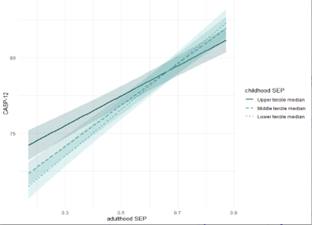
Figure 1. The interaction between childhood and adulthood SEP on CASP-12 (CI 95%), including financial distress, all control and independent variables, and the interaction of both SEP
Childhood conditions seem to have an independent influence on life satisfaction. In a model where childhood and adulthood SEP are both introduced, the analysis reveals that every additional point of increased, childhood SEP adds 1.3 points, and adulthood SEP adds 2.1 points to the life satisfaction score. After controlling for financial distress, every additional point of increased, childhood SEP remains at the level of 1.3 points, but adulthood SEP is significantly reduced and adds only 0.6 points. This suggests that early life influence on life satisfaction is only partially transmitted through financial distress. The impact of childhood and adulthood SEP on life satisfaction is relatively small, but the impact of adulthood SEP is reduced more than childhood SEP when the level of financial distress is controlled for.
Figure 2 reveals that concerning life satisfaction, childhood and adulthood SEP has a cumulative impact over the life course. High levels of adulthood SEP increase the life satisfaction of people who grew up in advantaged childhood circumstances. It is worth mentioning that this is contrary to the outcomes we saw for subjective well-being (CASP-12).
Discussion
These findings help explain some of the mixed results in the literature on the effects of childhood and adulthood SEP on the well-being of older adults. Overall, the results support the view that childhood SEP and adulthood SEP both have an impact on the current QoL of older people. This is consistent with the earlier findings that childhood, socioeconomic status matters, albeit indirectly, with the more proximal, adult, socio-economic status mediating the effects of childhood circumstances on QoL (Blane et al., 2004; Blane et al., 2012; Kendig et al., 2016; Vanhoutte & Nazroo, 2016; Wahrendorf & Blane, 2015; Wildman et al., 2018).
The correlation between well-being and life satisfaction is not very strong, as these two variables measure different aspects of QoL. Therefore, it is not surprising that the two dimensions of the current QoL of older people relate, to differing degrees, to childhood and adulthood SEP, as more proximal circumstances might have a bigger impact on the current thoughts and feelings regarding different aspects of well-being, measured by CASP-12, and the overall retrospective evaluation of one's life, measured by life satisfaction, is more related to the life course as a whole.
The results demonstrate that both measures of current QoL used in our sample are affected by childhood and adulthood SEP, and increased life course socio-economic advantages are associated with a greater sense of well-being. The impact of childhood and adulthood SEP is still present for both measures of QoL, although to different degrees. These results are consistent with previous findings that childhood circumstances have been found to have both a direct and indirect effect on QoL in later years (Deindl, 2013; Kendig et al., 2016; Wahrendorf & Blane, 2015; Wildman et al., 2018).
Adulthood SEP has a greater effect on well-being (CASP-12), suggesting that more proximal circumstances are more closely related to the current well-being of older people and that earlier life circumstances tend to have a weaker effect. This is in line with previous findings that current and mid-life socio-economic circumstances contribute significantly to later-life QoL (Blane et al., 2004; Kendig et al., 2016; Niedzwiedz et al., 2012; Wahrendorf, 2014).
The associations between childhood SEP and life satisfaction remained the same when adulthood SEP and current financial distress were introduced to the regression analysis, indicating that more proximal factors do not have a mediating effect concerning life satisfaction, and so this measure of QoL behaves differently.
The findings also reveal that current financial distress is a key component of the current QoL (both CASP-12 and life satisfaction) of older people. However, SEP variables have different associations with these two measures of QoL. After controlling for childhood and adulthood SEP together, and adding the indicator of current financial distress, the results showed that the impact of childhood SEP on well-being (CASP-12) decreases more than adulthood SEP. This could mean that the effects of childhood circumstances are mediated through adulthood circumstances, and a more proximal experience has a greater impact on well-being. The significance of the effect is different for life satisfaction. After controlling for childhood and adulthood SEP together, the results showed that the impact of childhood SEP decreased slightly more than adulthood SEP, but after the inclusion of current financial distress into the analysis, it appeared that the impact of childhood SEP on life satisfaction decreased far less than adulthood SEP. This might be related to the nature of measuring life satisfaction. It reflects the overall, cognitive evaluation of life, including the childhood environment. Thus, the latter might yield a stronger effect in relation to the life satisfaction indicator.
The inclusion of the interaction terms between childhood and adulthood SEP into the models saw different patterns for CASP-12 and life satisfaction. The analysis indicated a very weak compensatory effect of adulthood SEP on CASP-12. However, for life satisfaction, we observed a different picture, where the accumulating effect of adulthood SEP dominated. The interaction between the effects of childhood and adulthood SEP show that adverse living conditions in adulthood strengthen the effect of early life disadvantages on life satisfaction in later life, and therefore are an indication of the cumulative inequality over the life course.
On a conceptual level, this finding is in line with the existing framework of cumulative disadvantages over the life course and its origin in early childhood (Dannefer, 2003; Ferraro & Shippee, 2009). Our analysis indicates a direct and relatively strong effect of disadvantageous, childhood, socio-economic circumstances on life satisfaction (see also Deindl, 2013). Individuals who have not experienced early adversities may subjectively view life more positively than those who suffered stresses in childhood, regardless of objective outcomes (Ferraro & Shippee, 2009).
This study adds to the existing literature a more systematic knowledge of the associations between QoL measures in later years and childhood and adulthood SEP. The data reveals, through the measure of subjective well-being, the possibility of more advantageous adulthood circumstances outweighing disadvantaged conditions in childhood.
Conclusion
The results demonstrate that a better SEP over the life course increases well-being in later years. Both childhood and adulthood SEP have a direct impact on QoL measures in later years: adulthood SEP has a stronger impact on well-being (CASP-12) with or without controlling for current financial distress level, and childhood SEP has a greater impact on life satisfaction after controlling for the level of financial distress. The latter result suggests that life satisfaction is affected by childhood SEP both directly and indirectly through adulthood SEP. Current financial distress has a strong impact on the current QoL of older people, with a significant effect on how childhood and adulthood SEP affect later life.
We have made one contribution to the existing literature: we found that concerning CASP-12, adulthood SEP seems to display a slight, compensatory effect, whereas the cumulation of (dis)advantages seems to affect life satisfaction, though it is important to be aware that different measures of QoL might yield different results.
The results of this study have both strengths and limitations. The strengths are that the two measures of QoL (CASP-12 and life satisfaction) and the multidimensional, relative measure of childhood and adulthood SEP, cover a broad range of socio-economic circumstances. While attrition and recall bias may have affected the results, the data from the next panel wave (5) after the initial drawing of the sample in wave 4 has a retention rate of 85.6%, and there might also be a slight loss of data among more disadvantaged people. As only primary respondents are included in the analysis to prevent overlapping input data for the same household, the limitation is also the unweighted data. The financial distress indicator was measured at a time of economic crisis in Estonia (2011), which might have given the results a different meaning than in more stable years of development. The results presented here are derived only from Estonia, which is considered a special case amongst CEE countries, due to the rapid, societal transformation after the collapse of the communist regime, and therefore cannot be fully extended to all other CEE countries without further analysis. Due to the scarcity of 4th and 5th-wave data on post-communist and East European countries, a similar comparative analysis in the future is recommended. We also focussed our line of study more on the path-dependency concept of accumulation of (dis)advantages, and so between-group inequalities could be studied further in Estonia in the future.
These findings have important implications for policymaking. Childhood and adulthood SEP are both important for later life QoL, meaning that alleviating inequalities both in childhood and adulthood is important. Reducing financial distress in old age could improve the QoL of older people and reduce the accumulated inequalities during the life course.














